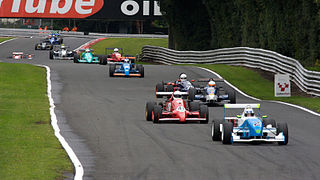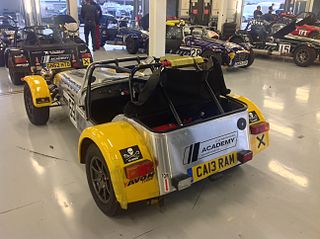
A Locost is a home-built car inspired by the Lotus Seven. The car features a space frame chassis usually welded together from mild steel 1 in × 1 in square tubing. Front suspension is usually double wishbone with coil spring struts. The rear is traditionally live axle, but has many variants including independent rear suspension or De Dion tube. Body panels are usually fibreglass nose and wings and aluminium side panels. Each car is highly individualized according to the resources, needs and desires of each respective builder.

The Lotus Seven is a sports car produced by the British manufacturer Lotus Cars between 1957 and 1973. The Seven is an open-wheel car with two seats and an open top. It was designed by Lotus founder Colin Chapman and has been considered the embodiment of the Lotus philosophy of performance through low weight and simplicity. The original model was highly successful with more than 2,500 cars sold, due to its attraction as a road legal car that could be used for clubman racing.

Lotus Group is a British multinational automotive manufacturer of luxury sports cars and electric vehicles.

Anthony Colin Bruce Chapman was an English design engineer, inventor, and builder in the automotive industry, and founder of the sports car company Lotus Cars.
Caterham Cars Ltd. is a British manufacturer of specialist lightweight sports cars established in Caterham, England, with their headquarters in Dartford, England. Their current model, the Caterham 7, originally launched in 1973, is a direct evolution of the Series 3 Lotus Seven designed by Colin Chapman. In the 1990s the company made the Caterham 21, a two-seater soft top alternative to the MG F and Lotus Elise,. A track-only car, the SP/300.R, a joint project with Lola was released for customer testing in 2010 and was scheduled for release in 2013.

The Caterham 7 is a super-lightweight sports car produced by Caterham Cars in the United Kingdom. It is based on the Lotus Seven, a lightweight sports car sold in kit and factory-built form by Lotus Cars, from 1957 to 1972.

Lotus Elan is the name of two separate ranges of automobiles produced by Lotus Cars. The first series of cars was produced between 1962 and 1975 as a rear-wheel drive vehicle. The second series was produced between 1989 and 1995 as a front-wheel drive vehicle.

British Racing Motors (BRM) was a British Formula One motor racing team. Founded in 1945 and based in the market town of Bourne in Lincolnshire, it participated from 1951 to 1977, competing in 197 grands prix and winning seventeen. BRM won the constructors' title in 1962 when its driver Graham Hill became world champion. In 1963, 1964, 1965 and 1971, BRM came second in the constructors' competition.

The Austin 7 is an economy car that was produced from 1922 until 1939 in the United Kingdom by Austin. It was nicknamed the "Baby Austin" and was at that time one of the most popular cars produced for the British market and sold well abroad. Its effect on the British market was similar to that of the Model T Ford in the US, replacing most other British economy cars and cyclecars of the early 1920s. It was also licensed and copied by companies all over the world. The first BMW car, the BMW Dixi, was a licensed Austin 7. In France they were made and sold as Rosengarts, and in the United States they were built by the American Austin Car Company. In Japan, Nissan also used the 7 design as the basis for their first cars, although not under licence. This eventually led to a 1952 agreement for Nissan to build and sell Austins in Japan under the Austin name.

Formula Ford, also known as F1600 and Formula F, is an entry-level class of single-seater, open-wheel formula racing. The various championships held across the world has historically been an important step for many prospective Formula One drivers. Formula Ford has traditionally been regarded as the first major stepping stone into formula racing after karting. The series typically sees career-minded drivers enter alongside amateurs and enthusiasts. Success in Formula Ford can lead directly to other junior formula series such as a Formula Renault 2.0 and Formula Three, or F1 Academy for female drivers, and previously the W Series, prior to the series folding.

The Lotus 49 was a Formula One racing car designed by Colin Chapman and Maurice Philippe for the 1967 F1 season. It was designed around the Cosworth DFV engine that would power most of the Formula One grid through the 1970s. It was one of the first F1 cars to use a stressed member engine combined with a monocoque to reduce weight, with other teams adopting the concept after its success. An iteration of it, the 49B, also pioneered the use of aerofoils to generate downforce.

The Lotus Mark I was the first car designed and built by Colin Chapman in 1948, while Chapman was still a student at the University of London. The car was designed to compete as a trials car, and was constructed on an Austin 7 chassis and running gear and given registration number OX 9292. Chapman built the body utilizing a composite made of thin aluminium bonded to plywood. He modified the rear suspension to give better handling and the engine to give more power. His approach to automobile construction using sound engineering principles and ingenious chassis design set the stage for many more revolutionary designs to follow. Although the original Mark I has been lost to history after being bought by a mysterious buyer in 1950, a replica was created to the same dimensions that uses an identical Austin chassis and running gear. Chapman and his future wife competed with the car in English Trials, a form of competition over rough terrain against time. Chapman continued to develop and modify the Mark I. First larger wheels and tyres were fitted and the front beam axle was split and hinged in the centre to provide independent front suspension. The success of the car helped encourage Chapman to continue designing competition cars.
Lotus Mark III was a single-seater sports car built by Colin Chapman as a 750 Racer. It was the first car to ever be called a "Lotus".
Lotus Mark IV was a trials car by Colin Chapman built on an Austin 7 chassis. Chapman's success at building trials cars brought another previous customer, Mike Lawson, to order a second trials car in 1952 to replace his Lotus Mark II, in which he won the Wrotham Cup. Once again Chapman chose an Austin Seven as the starting point, reinforcing the frame and installing a four-cylinder 1,172 cc (71.5 cu in), Ford, sidevalve engine. Chapman used all the tricks he had learned in his previous cars, constructing a lightweight aluminium body with a rounded nosecone. He fitted a 3-speed transmission taken from a Ford 8 and the divided front axle as on his previous cars.

The Lotus Mark VI is the first production car by Lotus Cars. It was introduced by Colin Chapman in 1952 after previously building multiple trials and road racing cars. The heart of the Mark VI is a semi-space frame chassis. Rather than a complete car, it was available to the general public as kit, wherein the customer could install any preferred engine and gearbox, making it eligible for a wider number of formulae.

The Monoposto Racing Club is a single seater, open-wheeled motor racing club in the United Kingdom. Its members race a variety of single seater race cars ranging from 1000cc "Mono Moto" cars to 2000cc Formula Three and Formula Renault cars. Monoposto is Italian for 'Single Seater'. As of 2010, it is the largest single seater championship in the UK, with over 60 regular race entrants. The aim of the club is to organize single seater racing for the club racer.

The Lotus Mark VIII car was Colin Chapman’s first fully enclosed aerodynamic design. Chapman's basic requirements for the design were for a car of 1100 lbs powered by an 85 bhp engine and a maximum speed of 125 mph. Work began on this design in late 1953 and Chapman was assisted in the design of the body by the aerodynamicist Frank Costin, who was the brother of Mike Costin, his main collaborator.

The Lotus 16 was the second single-seat racing car designed by Colin Chapman, and was built by his Lotus Cars manufacturing company for the Team Lotus racing squad. The Lotus 16 was constructed to compete in both the Formula One and Formula Two categories, and was the first Lotus car to be constructed for Formula One competition. Its design carried over many technological features of the first Lotus single-seater, the Lotus 12, as well as incorporating ideas which Chapman had been developing while working on the Vanwall racing cars. Indeed, such was the visual similarity between the Vanwall and Lotus 16 designs that the Lotus was often dubbed the "mini Vanwall" by the contemporary motor sport press. Although the Lotus 16 only scored five Formula One World Championship points in the three seasons during which it was used, its raw pace pointed the way for its more successful successors, the Lotus 18 and 21.
Caterham Racing is the practice of racing Caterham Seven-type sportscars.

The Caterham Academy is a motor-racing championship exclusively open to novices, as their first foray into motorsport.

















